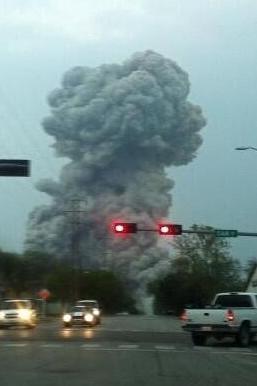Experts work to find cause of Texas fertilizer blast
(Our initial story on the West plant explosion and its aftermath can be read by clicking here.)
By GAUTAM NAIK
Experts are still trying to pin down the chain of events that triggered the mammoth explosion at a Texas fertilizer plant on Wednesday night, but such explosions are unusual because of the high temperatures required to ignite them.
 The facility, run by West Fertilizer Co., appears to be a place where agricultural fertilizer was likely stored, rather than manufactured. One of the main chemicals at the facility likely was ammonia -- a colorless, pungent gas that's stored in liquid form under high pressure in steel containers.
The facility, run by West Fertilizer Co., appears to be a place where agricultural fertilizer was likely stored, rather than manufactured. One of the main chemicals at the facility likely was ammonia -- a colorless, pungent gas that's stored in liquid form under high pressure in steel containers.
But because ammonia is relatively stable and only ignites at a temperature of 1562 degrees Fahrenheit, such events are rare.
"This is pretty new to us," said Kathy Mathers, spokeswoman for The Fertilizer Institute, or TFI, a US trade association for the fertilizer industry. "It's not something we are familiar with in our business."
While nitrogen is found widely in the environment, many plants aren't especially efficient at using it for growth. Fertilizer provides nitrogen in a form that's easier for plants to take up.
Mined minerals such as potash and phosphates are a type of fertilizer that can be spread. Another fertilizer is ammonia gas, a combination of nitrogen and hydrogen. In the US, ammonia gas is often directly injected into the soil.
Nitrogen fertilizers are often made with a century-old technique known as the Haber-Bosch process. The process takes nitrogen out of the air and combines it with hydrogen obtained from natural gas.
When ammonia is heated, it expands. "Traditionally, that's our concern," said Ford West, president of TFI. "That's why tanks [that store ammonia] have safety release valves" that get triggered if the pressure inside rises past a certain point.
It's not clear what occurred at the Texas facility. The fire which preceded the blast could have heated up the storage tanks and set off the explosion. For now, though, "that is still speculation," said Mr. West.
Another fertilizer is ammonium nitrate, which is easy to spread and often used for specialty crops, fruits and vegetables. The product is highly combustible but requires a fuel booster before it can ignite. Ammonium nitrate is also to make explosive and was the material used in the deadly Oklahoma City bombing of April 19, 1995.
It is not known if ammonium nitrate was stored at the Texas facility.
Dow Jones Newswires






Comments